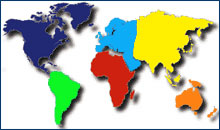Top 10 festivals in Europe
From the Running of the Bulls in Pamplona to the Shakespeare Festival in Stratford-upon-Avon, here are the top festivals in Europe
This is a highly subjective list of ten major European festivals. I've tried to balance it geographically and thematically (which is a fancy way to say all across the continent and a mix of folk, Christian, and cultural). There is, admittedly, a bit of emphasis on the famous ones—Oktoberfest in Munich, the Running of the Bulls in Pamplona, the Palio in Siena, Shakespeare season in the Bard's hometown.
Carnevale, Venice, Italy (and just about everywhere else)
Carnival is a true pagan holdover grafted onto the Christian pre-Lenten period. It's a feast of food and wine and a raucous celebration of spring where the world is turned upside down, allowing the lowliest to hobnob with the elite, and where everyone has a roaring good time. The whole Christian world celebrates this event (think Rio or New Orleans), but in Europe the most famous is Carnevale, the series of elegant-yet-drunken masked balls held in Venice; the holiday recalls the randy old days of Casanova's 18th century.
Carnevale just about anywhere is a trip, from the satiric political floats in the port of Livorno, Italy; to the flower battles and bonfires in Nice, France; to the solemn burial of a sardine in Madrid, Spain (no, really!); to the chariot parades and wild bacchanal in the Greek city of Pátras. Carnival starts two or three weeks before Ash Wednesday (which usually means late February) and culminates in the final Tuesday—called "Fat Tuesday," which in French is "Mardi Gras"—before the sober period of Lent begins.
Shakespeare season, Stratford-upon-Avon, England
For fans of great theater, this a wonderful experience. The town where the Bard was born (and to which he retired) does a brisk business in the Shakespeare trade, and they'd never settle for anything less than the Royal Shakespeare Company performing its season here. You can get tickets through agents such as Keith Prowse (tel. 800-669-8687 in the United States); the season lasts from April through January.
Easter, celebrated all across Europe
Celebrations vary widely between Good Friday and Easter Monday. In Florence, an ox-drawn cart laden with fireworks explodes in front of the cathedral; in Seville, Spain hooded processioners wail love songs to the Virgin; multicolored floats parade around Battersea Park in London. Easter falls around late March/early April.
Palio, Siena, Italy
This bareback, breakneck, anything-goes horse race around the dirt-covered sloping main piazza of medieval Siena is one of the highlights of the Italian summer. Whips are used as much on the other riders as on the horses, and even a horse who's thrown its rider (far from uncommon) can take the prize. No matter who wins, the parties held before and afterward are street feasts to behold—and take part in. The people have so much fun, they have to do it twice: July 2 and August 16.
Running of the Bulls, Pamplona, Spain
Surely one of the more dangerous festivals is that crazy week where people dressed in white with red kerchiefs let rampaging bulls chase them through the narrow streets of Pamplona. The mayhem lasts until the beasts, after trampling/goring a few of the slower runners and forcing most to jump the fences for safety, chase the last few right out into the harbor's waters. Much wine is consumed, fireworks are set off, and, of course, there are bullfights galore. You can enjoy it vicariously via Hemingway's The Sun Also Rises or see it yourself from July 6 to 14.
Bastille Day, Paris, France
France celebrates its birth as a nation with parades, street fairs, feasts, and pageants. It starts with a procession along the Champs-Elysées and ends with fireworks over Montemarte. Bastille Day is July 14.
Edinburgh Festival, Edinburgh, Scotland
One of Europe's premier cultural extravaganzas, this festival brings to town plays, film, music, dance, and art from some of the world's top performers and creative talents for three weeks every August. It's so big that it has spawned a Fringe Festival, which opens even more venues across town to smaller, more experimental acts. The highlight is the traditional bagpipes-and-kilt Military Tattoo at the castle.
Bloemencorso, Amsterdam, the Netherlands
This is one of the major flower festivals in a country obsessed with blooms. It starts as an inherently colorful parade of floral floats in the nearby flower market town of Aalmeer and ends in Amsterdam on the Dam Square. (Believe it or not, there are no tulips.) It takes place on the first Saturday in September.
Oktoberfest, Munich, Germany
Picture tens of thousands of people sitting under giant tents draining liter-sized mugs of beer while whole oxen roast on spits and brass bands oompah in the background. Welcome to the world's biggest keg party (five million liters of beer all told). It actually starts two weeks before the end of September; the first weekend in October is the final flourish.
Christmas season, Europe-wide
It's a fun and festive time to be anywhere in Europe from a few weeks before the holiday until January 6 (the Epiphany). And luckily, in Europe, Christmas hasn't yet been completely commercialized.
Be on the lookout for crèches (nativity scenes) in church chapels and public squares across the continent. Some are post-modern, some live, others are ultra-traditional. (My favorite is the one in Naples where the holy manger is an insignificant detail surrounded by a very Italian Bethlehem, complete with pizza parlors.)
You can sing Silent Night on Christmas Eve in the town where it was written (Oberndorf, north of Salzburg, Austria), or watch the pope lean out his window in Rome at noon to give a mass blessing broadcast around the world on December 25.
Related Articles |
Outside Resources |
This article was last updated in August 2007. All information was accurate at the time.
Copyright © 1998–2010 by Reid Bramblett. Author: Reid Bramblett.



 ShareThis
ShareThis

